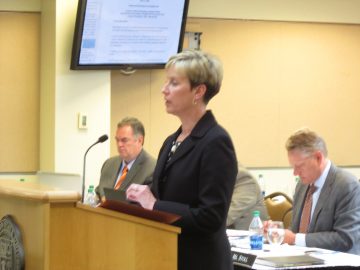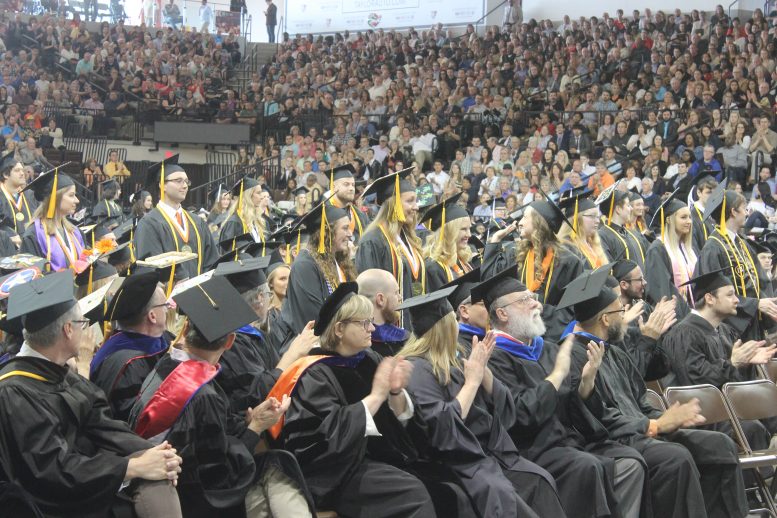By DAVID DUPONT
BG Independent News
Bowling Green State University’s efforts to recruit student better prepared for college and then to make sure those students stay around to graduate in a timely manner is paying off.
In presenting BGSU’s budget to trustees Thursday, Chief Financial Officer Sheri Stoll said that while the amount appropriate to support higher education is stagnant, BGSU is getting more.
State funding, which makes up about a quarter of the university’s revenue, is based on how many students graduate and how many successfully complete courses.
University officials have made these a priority.

Sheri Stoll addresses university trustees
The result, Stoll reported, is that BGSU’s state share of funding is increasing 1.7 percent, to just under $77.9 million, in the operating budget that will go into effect July 1.
That budget is tight, Stoll told the university’s Board of Trustees Thursday. It calls for $422.2 million in spending with $423.8 million in revenue, almost half of which comes from tuition and fees.
Tuition rates have been flat both because the university opted not to raise tuition and some years, and the state has nixed hikes in recent years.
The state has now allowed universities to implement tuition guarantee programs. Through these, tuition for first year students can be increased, but that tuition is guaranteed to stay the same for four years. Tuition for the incoming class will be 5.9 percent higher. The university also raised the out-of-state surcharge and graduate student fees.
These changes plus a modest increase in enrollment is bringing in more money. Stoll said her assumptions were “very conservative.” Last year more students were expected but then there was “a melt,” largely because international graduate and undergraduate students decided not to come. That decline in international enrollment was felt at colleges and universities across the country.
She also said it was too early to figure in the impact of online courses and new professional master’s degrees.
The largest increased expenditure comes from salaries and benefits, which make up over half the expenses.
Based on the faculty union contract, the amount spent on faculty will be 3.66 percent more.
The contract calls for a 3 percent increase in the pool divided evenly for an across the board increase, merit, and market adjustments. There are also pools of money to increase pay as faculty receive promotion and tenure and for the provost to make salary adjustments based on the market.
The amount available for administrative and classified salaries will increase by 2 percent. In line with that, the trustees approved a 2-percent increase for campus police officers.
Interim Provost John Fisher reported on the steps BGSU is taking to increase its retention and graduation rates.
These numbers are reported to the state, but he said some don’t reflect the current situation, since they are based on classes enrolled before many of the initiatives were launched.
Fall-to-fall retention for first year students at BGSU has most recently been about 77 percent. The goal is to bring it to 80 percent by 2020.
For students who enrolled in BGSU in 2011, 52.3 percent ended up graduating within six years. The goal is to bring that to 70 percent by 2026.
Fischer noted that at the same time as the trustees were meeting, the Student Success Council was meeting. That group looks at ways in which students are challenged and what can be done to address those challenges.
Those can be financial or academic, he said.
The university has been using data to pinpoint as early as possible students who are in danger of dropping out.
Those issues vary, Fischer said. Some students are struggling financially, others may have a hard time adjusting to the rigors of college academics.
Fischer said that from the time students step on campus, the university is focused on keeping them there until they step across the platform to graduate.
They work with their advisors to develop a clear plan to graduation that has them taking at least 15 credits a semester.
Students, he said, who are undecided or switch majors, are encouraged “to quickly transition into a degree program.”
Summer and online courses are also available for students to pick up credit. And BGSU involvement in the College Credit Plus means more students are arriving as first year students with college credit.
The university has also raised its admission standards, Fischer said, so incoming students are better prepared academically.
The programs, President Rodney Rogers said, may seem like “a laundry list.” They are, however, “very targeted to variety of different students.
“I appreciate the comprehensive nature of these strategies,” Rogers said. “If we admit them, we want them to graduate as timely as possible and prepared to be successful and go far.”
Trustee Richard Ross offered his “kudos” for those efforts. “This is really significant in so many ways. It reduces the cost to moms and dads and students if they actually graduate on time to or close to it. This is really important work.”
The university has also been developing more degree programs as a way of attracting students. On Friday, trustees approved a Bachelor of Arts in Advertising and a Master of Science in Athletic Training.
The advertising degree in the School of Media and Communication addresses “above average demand” in the market, including Northwest Ohio, said Fischer.
It will offer tracks in production and management.
The Athletic Training degree builds on the success of BGSU’s exercise science program in the School of Human Movement, Sport, and Leisure Studies, Fischer said. It will give students the credential they need to get hired as a professional trainer.
The program, Fischer said, will have a focus on addressing the needs of underserved populations and a global market.
It will offer undergraduate students in exercise science an accelerated path so they can move directly from their undergraduate studies into graduate work.





